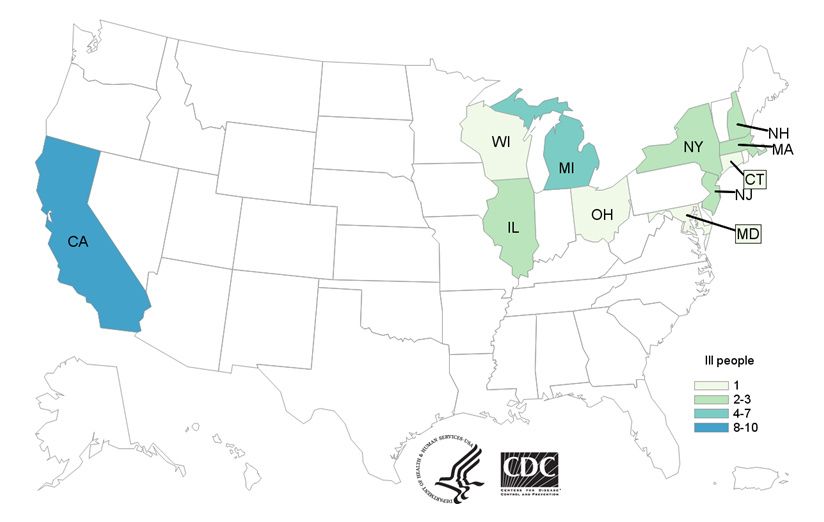

If you’re hosting Thanksgiving tomorrow, be sure to leave romaine lettuce off the menu! The Center for Disease Control and Prevention (CDC) and the U.S. Food and Drug Administration (FDA) are warning everyone to avoid the classic salad green until investigators can pinpoint the exact source of an E. coli outbreak that has sickened 32 people in 11 states.
The FDA advised Americans to stop eating romaine and to toss any that’s left in the fridge. Restaurants and retailers should also stop serving it until more is known.
FDA, @CDCgov, & partners are investigating a new multistate outbreak of E. coli likely linked to romaine lettuce. Consumers nationwide shouldn’t eat & should discard romaine lettuce. Retailers, restaurants, food service operators shouldn’t serve romaine https://t.co/vOf5LyaVM4 pic.twitter.com/R78MFn0sIW
— U.S. FDA (@US_FDA) November 21, 2018
“The quick and aggressive steps we’re taking today are aimed at making sure we get ahead of this emerging outbreak, to reduce risk to consumers, and to help people protect themselves and their families from this foodborne illness outbreak. This is especially important ahead of the Thanksgiving holiday, when people will be sitting down for family meals,” FDA Commissioner Dr. Scott Gottlieb said in a press release issued Tuesday. “We want to get this information out to consumers early. While we’ve made progress, it’s still early in this investigation and work remains to pinpoint the source of contamination that contributed to this outbreak and allow us to employ more targeted measures to reduce future risk.”
Cases so far have been reported in California, Connecticut, Illinois, Massachusetts, Maryland, Michigan, New Hampshire, New Jersey, New York, Ohio and Wisconsin. The particular strain causing the outbreak is called Shiga toxin-producing E. coli O157:H7, according to the CDC alert. It has sent 13 people to the hospital so far, and no one has died.
A map of states where illness has been reportedCDC
Illnesses began on Oct. 8, and the last reported case was on Oct. 31. It usually takes about two to three weeks for someone to report an illness after first getting sick, so more people might have been infected since then, the CDC said. Public health workers believe romaine is the culprit because 79 percent of the 14 infected people interviewed so far said they ate romaine lettuce in the week before getting sick, but researchers have not yet been able to pinpoint a specific grower, supplier, brand or distributor to issue a recall.
A timeline of the outbreak so farCDC
The outbreak has also crossed the border into Canada, where 18 people in Quebec and Ontario have been infected so far.
Recent illnesses reported in Ontario and Quebec suggests that there is a risk of E. coli infections associated with eating romaine lettuce. Individuals in ON and QC should avoid eating romaine lettuce until more is known about the outbreak. Find out more: https://t.co/vtJbr3WhrC pic.twitter.com/AbsPZ5sFQt
— Health Canada and PHAC (@GovCanHealth) November 21, 2018
This isn’t the first time salad has made people sick in the U.S. and Canada. The strain of this outbreak has a similar DNA fingerprint to one in 2017 that was linked to leafy greens in the U.S. and romaine lettuce in Canada.
The symptoms of Shiga toxin-producing E. coli kick in two to eight days after initial infection. They usually include stomach cramps and bloody diarrhea, and sometimes a fever of 101 degrees or lower, according to the FDA. It usually clears up after five to seven days, but 5 to 10 percent of people who get it develop hemolytic uremic syndrome (HUS), a potentially life-threatening condition. The FDA explains:
Symptoms of HUS include fever, abdominal pain, feeling very tired, decreased frequency of urination, small unexplained bruises or bleeding, and pallor. Most people with HUS recover within a few weeks, but some suffer permanent damage or die. People who experience these symptoms should seek emergency medical care immediately. Persons with HUS should be hospitalized because their kidneys may stop working (acute renal failure), but they may also develop other serious problems such as hypertension, chronic kidney disease, and neurologic problems.
If you think you are coming down with E. coli, the CDC advises that you:
- Talk to your doctor.
- Write down what you ate the week before you got sick.
- Alert the health department.
- Answer any questions public health employees ask you about your illness.

 233k
233k  41k
41k  Subscribe
Subscribe 

